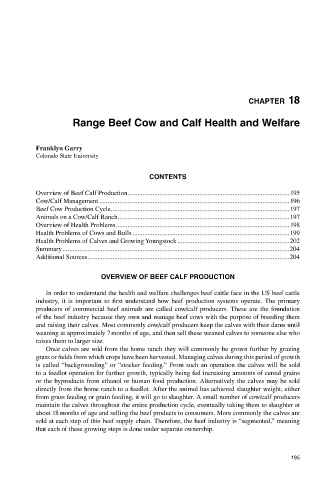Page 218 - The Welfare of Cattle
P. 218
ChaPter 18
range Beef Cow and Calf health and Welfare
Franklyn Garry
Colorado State University
CONteNtS
Overview of Beef Calf Production ................................................................................................. 195
Cow/Calf Management ..................................................................................................................196
Beef Cow Production Cycle ...........................................................................................................197
Animals on a Cow/Calf Ranch.......................................................................................................197
Overview of Health Problems ........................................................................................................ 198
Health Problems of Cows and Bulls ..............................................................................................199
Health Problems of Calves and Growing Youngstock ...................................................................202
Summary ........................................................................................................................................204
Additional Sources .........................................................................................................................204
OVerVIeW OF BeeF CaLF PrODUCtION
In order to understand the health and welfare challenges beef cattle face in the US beef cattle
industry, it is important to first understand how beef production systems operate. The primary
producers of commercial beef animals are called cow/calf producers. These are the foundation
of the beef industry because they own and manage beef cows with the purpose of breeding them
and raising their calves. Most commonly cow/calf producers keep the calves with their dams until
weaning at approximately 7 months of age, and then sell these weaned calves to someone else who
raises them to larger size.
Once calves are sold from the home ranch they will commonly be grown further by grazing
grass or fields from which crops have been harvested. Managing calves during this period of growth
is called “backgrounding” or “stocker feeding.” From such an operation the calves will be sold
to a feedlot operation for further growth, typically being fed increasing amounts of cereal grains
or the byproducts from ethanol or human food production. Alternatively the calves may be sold
directly from the home ranch to a feedlot. After the animal has achieved slaughter weight, either
from grass feeding or grain feeding, it will go to slaughter. A small number of cow/calf producers
maintain the calves throughout the entire production cycle, eventually taking them to slaughter at
about 18 months of age and selling the beef products to consumers. More commonly the calves are
sold at each step of this beef supply chain. Therefore, the beef industry is “segmented,” meaning
that each of these growing steps is done under separate ownership.
195

